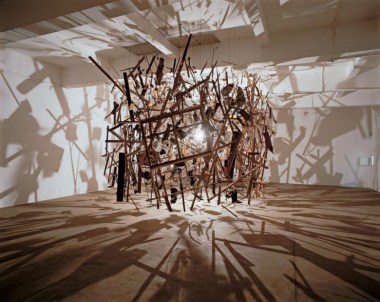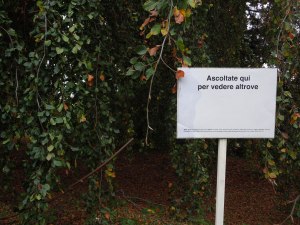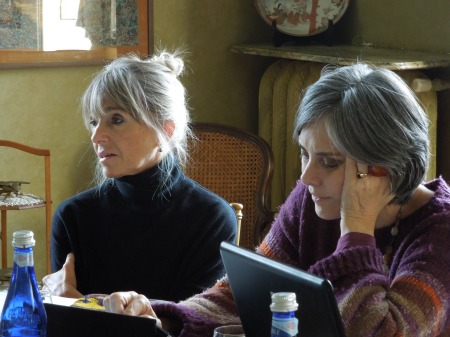The end of October 2013 was a time of many journeys.
To Villa Cernigliaro, a place of tall light-filled windows, rich silence, and walls that, over the decades, had overheard countless literary conversations. Perfectly befitting Carter, a three-day workshop organised by and for professional literary translators.
What, I wondered, would I have to do?
As the invited guest author, perhaps I’d find myself in a precarious position, both inside and out, keen to contribute yet careful not to intrude. I’d never before been privy to the process of translation, and didn’t quite know what to expect.
The first evening was a welcoming – we made our introductions, touching briefly on the texts to work on. A laying out, by Susanna and Rossella, of the hopes and ambitions behind Carter. There were veterans there, and others for whom the workshop was a first. We nibbled on chocolate chestnuts. Someone placed an apple in the centre of the table for good luck. Then we dispersed for dinner and wine.
The next few days can only be described as revelatory.
We began with a short piece I’d written in 2007, ‘This is not the Story’, at a point when I was feeling particularly uninspired about writing – my own and others around me. (It might have had something to do with the fact that I was stuck in a nine to five job, wondering whether I’d ever ‘become’ a writer.) I picked certain tropes – the outsider, the stranger, the angry protagonist – the ones present in many of the books I loved and felt were missing from my literary life, and turned them into a void, a ‘non-story.’ It was fascinating to watch how the translators picked up on the voices within the piece, the various texts conversing with each other. Cristina related it to Magritte’s painting This is not a pipe – a connection I hadn’t thought of but it could be illuminating.
Next, we moved on to the first few sections of my novel Seahorse, that had seen recent major revisions. A week before the workshop, I sent Gioia an email – “Darling, please don’t yell at me! Could we use these pages for Carter (and not the ones I sent you earlier??).” She was all too kind, saying “this is magic. Because one of Susanna’s idea was to study how the text had changed.”
And changed it had. A lot.
Which the group of translators found fascinating because, as they explained, translating largely involves working out authorial intention. Why this word, and not another? Why has ‘whore’ changed to ‘prostitute’ in the next draft?
Since the narrative voice was now first person, it threw up the issue of gender – something I’d given little thought to while rewriting Seahorse. English is a language bereft of gender, its inflections and grammar giving away little or nothing at all of the narrator’s sex. Yet Italian, constructed intricately from feminine and masculine words, would notice its appearance and disappearance. We discussed ways to keep gender secret, ways for it to be slowly revealed.
Sitting in that room in Villa Cernigliaro, in my corner, watching the group at work around the tables in the centre, brought to mind Cornelia Parker’s artwork Cold Dark Matter: An Exploded View. The installation captured a garden shed, suspended in the air, at the moment of it being exploded.
“[T]he shed functions as a place of refuge, a safe place, a place for secrets and fantasy. By blowing up the shed Parker is taking away such a place, throwing doubt on all it represents. Its contents are revealed, damaged in the process and yet somehow more eloquent. We get an ‘exploded view’ which creates a vast new space for our own mental activity.”
Pieced back together, Seahorse, I feel, reads all the better for having been dismantled by you all.
What I found more difficult was having to explain my poetry.
Not in the sense that I wasn’t keen to, but simply that, most of the time, I couldn’t. Here, lines lead their own lives much more than they do in prose, and it’s evidence of the translators great and tremendous skills, what they accomplished despite my hesitant mumblings, awkward explanations, and (often) unhelpful responses (such as ‘Sort of, I think.’)
By the end of the workshop, I knew that what I’d learned about translation, was merely the beginning. For some it’s a puzzle, a way of fitting words together. The understanding of not just a language, but an entire worldview. A box, constantly unfolding, enlarging, replete with hidden rooms and secrets. A process that spills over outside the work space, into dining rooms and garden walks, and long meal-time conversations. And, as I mentioned before our farewells, it’s an act of empathy. Of being able to place yourself into other lives. Such a generous, life-affirming gift.
Thanks to you all, I look at language with fresh eyes.
Janice Pariat







